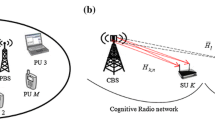Abstract
In this paper, a space division multiplexing (SDM) based joint adaptive beamforming downlink transmission scheme for infrastructured cognitive radio multi-input multi-output system is proposed. When spectrum holes exist traditional opportunistic spectrum access is employed. While there is no idle spectrum available, cognitive base station and cognitive user firstly evaluate spatial correlation between cognitive transmission and inter-system interference based on the preprocessed channel information. Incorporated with transmission gain, authorized frequency channel and eigenmode are jointly selected. Then on the premise that no interference is imposed on the primary, cognitive transmission is carried out adopting SDM. The proposed scheme exploits selection diversity of both authorized channel and cognitive eigenmode, thus achieves better spatio-frequency resource management and near-optimal cognitive throughput performance.
Similar content being viewed by others
References
Krenik, W., & Batra, A. (2005). Cognitive radio techniques for wide area networks. In Proceedings of design automation conference (DAC), pp. 409–412.
Mitola, J. (1999). Cognitive radio for flexible mobile multimedia communication. In Proceedings of IEEE international workshop mobile multimedia communication (MoMuC), pp. 3–10.
Zhang R., Lim T., Liang Y.-C., Zeng Y. (2010) Multi-antenna based spectrum sensing for cognitive radios: A GLRT approach. IEEE Transactions on Communications 58(1): 84–88
Scutari G., Palomar D. P. (2010) MIMO cognitive radio: A game theoretical approach. IEEE Transactions on Signal Processing 58(2): 761–780
Krikidis I. (2010) A SVD-based location coding for cognitive radio in MIMO uplink channels. IEEE Communications on Letters 14(10): 912–914
Li Z., Zhao L., Liu Q. (2011) Space division multiplexing based opportunistic spectrum access in cognitive radio network. Journal of Electron & Information Technology 33(5): 1172–1177
Li Z., Yang J., Yao J. (2010) Adaptive opportunistic transmission in MU-MIMO downlink with reduced feedback. Journal of Communications 5(7): 511–520
Zhao Q., Tong L., Swami A., Chen Y. (2007) Decentralized cognitive MAC for opportunistic spectrum access in ad hoc networks: A POMDP framework. IEEE Journal of Selected Areas in Communications 25(3): 589–600
Bakr, O., Johnson, M., Mudumbai, R., & Ramchandran, K. (2009). Multi-antenna interference cancellation techniques for cognitive radio applications. In IEEE wireless communications and network conference (WCNC), pp. 1–6.
Jitvanichphaibool, K., Liang, Y.-C., & Zhang, R. (2009). Beamforming and power control for multi-antenna cognitive two-way relaying. In IEEE wireless communications and network conference (WCNC), pp. 1–6.
IEEE. (2009). IEEE standard for architectural building blocks enabling network-device distributed decision making for optimized radio resource usage in heterogeneous wireless access networks. IEEE Std 1900. 4TM.
Author information
Authors and Affiliations
Corresponding author
Rights and permissions
About this article
Cite this article
Li, Z., Xiao, L. & Yang, J. Adaptive Beamforming in CR-MIMO System Exploiting Multi-Channel and Eigenmode Diversity. Wireless Pers Commun 68, 1403–1413 (2013). https://doi.org/10.1007/s11277-012-0530-9
Published:
Issue Date:
DOI: https://doi.org/10.1007/s11277-012-0530-9




